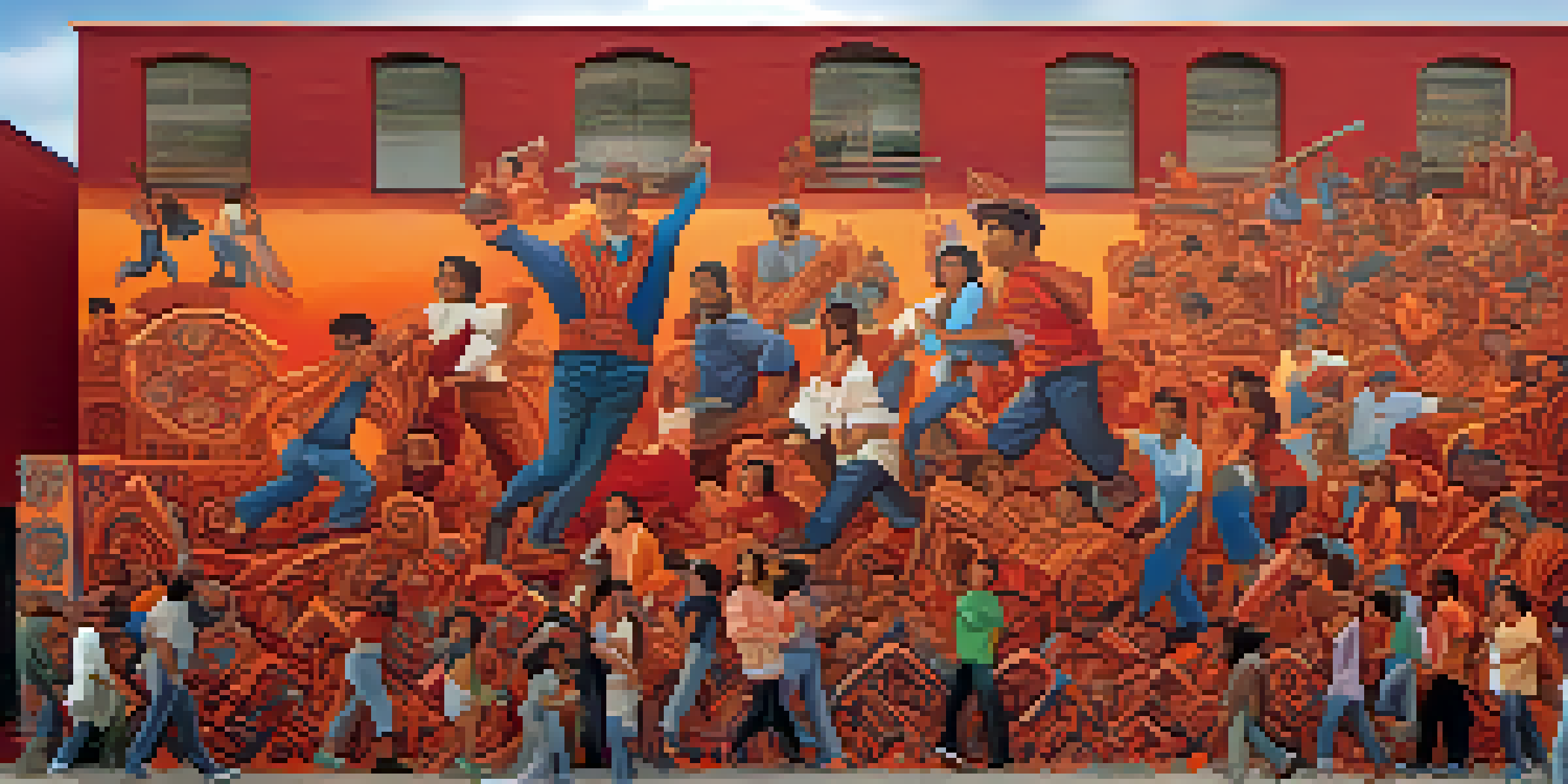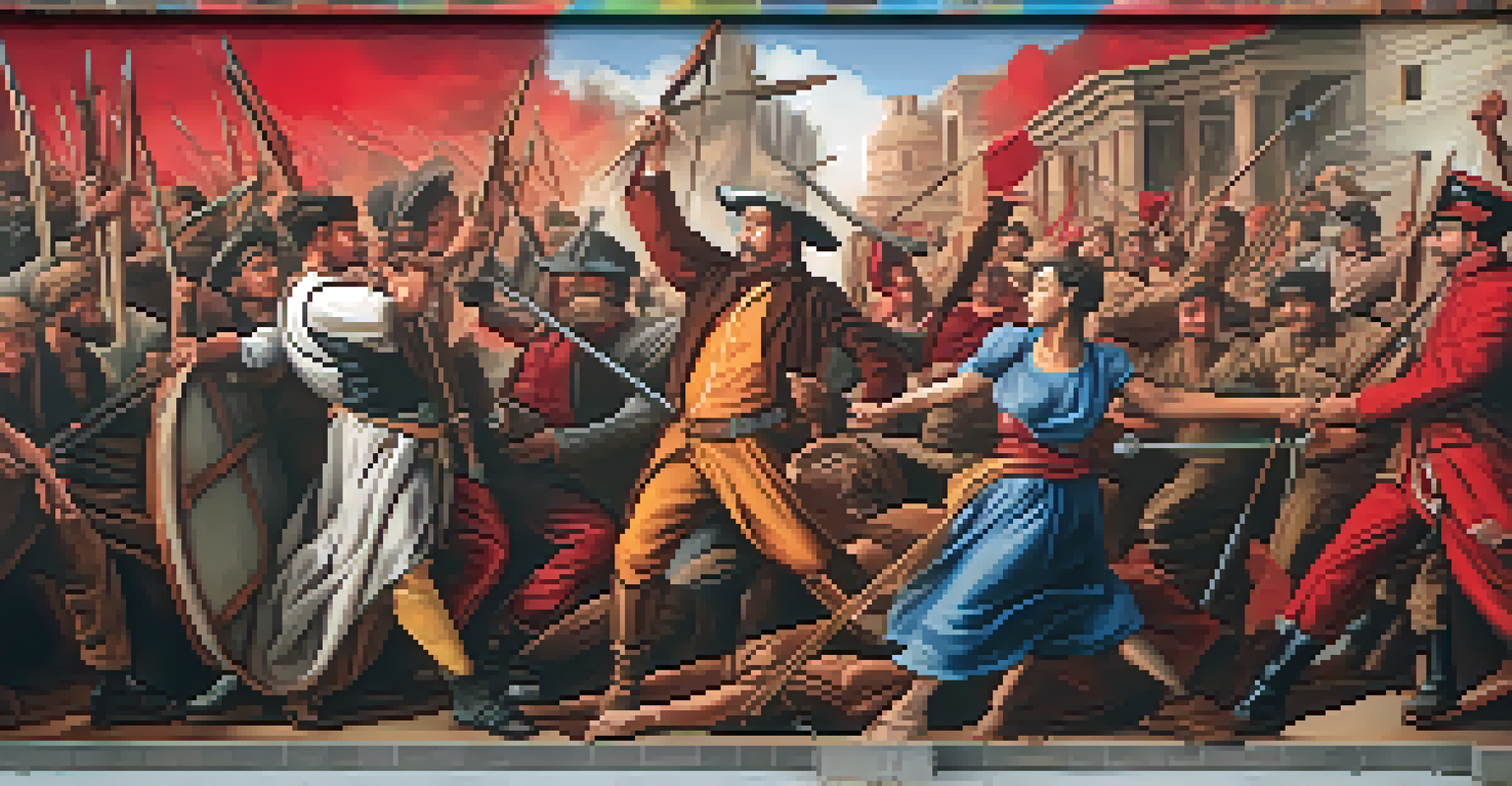Mexican Muralism: Telling Stories of Revolution and Identity

What is Mexican Muralism and Its Historical Context?
Mexican Muralism is an art movement that emerged in the early 20th century, rooted in the social and political upheaval following the Mexican Revolution. Artists sought to convey the struggles and aspirations of the Mexican people through large-scale murals, often found in public spaces. This movement was more than just aesthetics; it was a powerful vehicle for social commentary and national identity.
Art is not a mirror to hold up to society, but a hammer with which to shape it.
The revolution, which began in 1910, created a fertile ground for artists like Diego Rivera, David Alfaro Siqueiros, and José Clemente Orozco to express their visions. These murals often depicted themes of indigenous culture, class struggles, and the fight against oppression. By bringing art to public spaces, they ensured that their messages reached a broader audience, making art accessible to everyone.
As political turmoil continued, these artists used their work to advocate for social change, reflecting the hopes and dreams of a nation seeking its identity. Their murals became symbols of resistance and pride, intertwining art with the very fabric of Mexican society.
Key Figures in Mexican Muralism: Artists and Their Impact
Diego Rivera is perhaps the most well-known figure of Mexican Muralism, celebrated for his vibrant and detailed murals that often highlighted the struggles of the working class. His famous work, 'Man at the Crossroads,' originally intended for the Rockefeller Center, stirred controversy for its political messages and was ultimately destroyed. Rivera's commitment to portraying the common man's plight set a standard for the movement.

Another prominent artist, José Clemente Orozco, infused his work with a more somber tone, often focusing on the darker aspects of humanity and the consequences of war. His murals, such as 'Prometheus,' reflect a deep understanding of human suffering and resilience. Orozco's unique style and philosophy offered a counterbalance to Rivera's more optimistic perspectives.
Mexican Muralism's Historical Roots
Emerging post-Mexican Revolution, this art movement conveys the struggles and aspirations of the Mexican people.
David Alfaro Siqueiros, an ardent revolutionary, pushed the boundaries of muralism by experimenting with techniques and materials. His dynamic compositions and use of dramatic perspectives aimed to evoke emotional responses from viewers. Together, these artists not only transformed public spaces but also left a lasting legacy on art and social consciousness.
The Themes of Revolution in Muralism
Revolution is a recurring theme in Mexican Muralism, serving as a backdrop for many artists' narratives. The murals often depict the struggles against tyranny and oppression, celebrating the fight for justice and equality. These themes resonate with viewers, reminding them of the sacrifices made for freedom and the ongoing fight for rights.
The role of the artist is to make the revolution irresistible.
For instance, Rivera's murals frequently illustrate the exploitation of workers and the rich history of indigenous peoples, highlighting their resilience. By portraying these themes, artists not only preserved the memory of the revolution but also encouraged future generations to continue the fight. The murals serve as visual reminders of the power of collective action.
Moreover, the use of vibrant colors and dramatic imagery draws viewers in, making the messages even more impactful. The stories told through these murals are not just historical accounts; they are calls to action, urging society to reflect on its past and strive for a better future.
Cultural Identity and National Pride in Murals
Cultural identity plays a significant role in Mexican Muralism, as artists sought to reclaim and celebrate indigenous heritage. By incorporating traditional motifs and symbols, they aimed to instill a sense of pride among Mexicans. This revival of indigenous identity was crucial in a period when many felt disconnected from their roots.
For example, Orozco often featured themes of pre-Columbian mythology, using these symbols to connect contemporary struggles with historical narratives. This blending of past and present not only honors the rich cultural heritage but also invites viewers to reflect on their own identities. The murals serve as a canvas for exploring what it means to be Mexican.
Influential Artists and Their Impact
Key artists like Diego Rivera and José Clemente Orozco shaped Mexican Muralism by using their work to advocate for social change and reflect national identity.
As a result, these murals foster a sense of unity among the people, emphasizing shared experiences and values. In a society marked by division, the art becomes a powerful tool for solidarity, reminding everyone of their common heritage and the importance of preserving it.
The Influence of Mexican Muralism on Global Art
Mexican Muralism has transcended borders, influencing artists worldwide and inspiring movements that advocate for social justice. Its impact can be seen in various art forms, from street art to contemporary murals that address political issues. The ethos of using art as a means of communication and empowerment resonates with many artists today.
For instance, the social realism movement in the United States drew heavily from the themes explored in Mexican murals, emphasizing the struggles of marginalized communities. Artists like Judy Baca and the Los Angeles muralist community took inspiration from Rivera and Orozco, creating works that tell their own stories and fight for representation.
Furthermore, the techniques developed by Mexican muralists, such as large-scale public works and community engagement, have become standard practices in modern muralism. This global exchange of ideas demonstrates the enduring legacy of Mexican Muralism and its role in shaping not just art, but also social movements around the world.
Preserving the Legacy of Mexican Muralism Today
As time progresses, the challenge of preserving the legacy of Mexican Muralism becomes increasingly important. Many of these murals face threats from urban development, weathering, and neglect. Organizations and communities are now working together to restore and maintain these artworks, recognizing their cultural significance.
Additionally, educational programs are being developed to teach new generations about the history and impact of these murals. By engaging students and communities, these initiatives help foster appreciation for this art form and its messages. This preservation effort is crucial for ensuring that the stories told through these murals continue to inspire future generations.
Legacy and Global Influence
Mexican Muralism has influenced global art movements by emphasizing social justice and community engagement in public art.
Moreover, contemporary artists are merging traditional muralism with modern techniques, creating a dialogue between the past and present. This evolution not only honors the original artists but also keeps the movement alive, ensuring that the essence of Mexican Muralism continues to resonate in today's society.
Conclusion: The Enduring Relevance of Muralism
In conclusion, Mexican Muralism stands as a powerful testament to the resilience of a nation and its people. Through the vibrant colors and evocative themes, these murals narrate the stories of revolution, identity, and cultural pride. They remind us that art is not just for aesthetics; it is a tool for social change and unity.
As we navigate contemporary issues, the messages embedded in these murals remain relevant. The struggles for justice, equality, and identity that they portray continue to resonate with audiences today. By reflecting on these artworks, we can draw inspiration for our own journeys and the fight for a better world.

Ultimately, the legacy of Mexican Muralism is not just in the art itself but in its ability to connect people and inspire action. It invites us to look closely at our own stories and consider how we can contribute to the ongoing narrative of our communities.